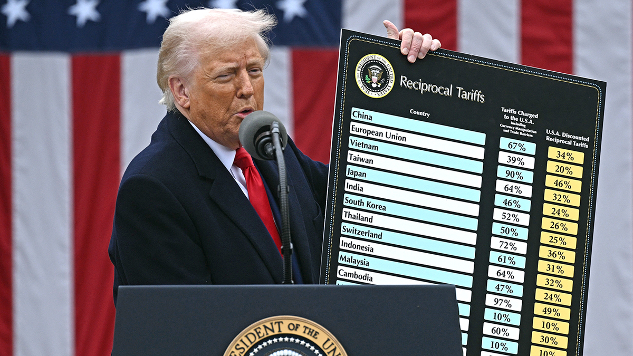
In This Article
- What makes a trade deal legally binding?
- Why Trump’s “agreements” with the EU and Japan aren’t enforceable treaties
- How the art of the deal became the illusion of progress
- Historical context: past presidents vs. Trump’s trade theatrics
- The cost of political optics on real-world policy
The Myth of the Trump Trade Deal: Theater Without Terms
by Robert Jennings, InnerSelf.comIf you want to call something a “deal,” it ought to act like one. A real trade agreement isn’t just a photo op or a press release; it’s negotiated line by line, signed, ratified by Congress (if it’s a treaty), and actually published so people can read it. It has to be legally binding. Enforceable. Durable. In other words, it needs to last longer than the time it takes Trump to change his mind or fire off another rage-tweet at 3 a.m.
But most of Trump’s so-called “deals” never made it past the paper-napkin stage. They were vague “understandings,” handshake moments with no legal foundation, PR stunts masquerading as policy. He called them “historic” while they functioned more like historic flops. From his clumsy NAFTA redo to the TPP pullout to the tariff tantrums with China, it was all about theater. No follow-through, no framework, just bluffing at the global poker table with an empty hand, betting the farm, the crops, and the tractor too. And somehow expecting applause for losing the game.
The European Union 'Deal': Investment Promises, Not Policy
Trump flaunted a “new chapter” in U.S.–EU trade, but what he actually got was a press release, not a treaty. The U.S. and the EU issued a joint statement pledging billions in purchases of soy, LNG, energy, and investment. But the European negotiators had no authority to bind private companies or national capitals to those figures. They operated under a mandate approved by all 27 member states, and still couldn’t deliver enforceable commitments. There was no signed text, no ratification, and no legal muscle behind the warm receptions and handshake photos.
This wasn’t diplomacy; it was a masquerade. Trump got headlines. EU leaders got pressured into accepting 15% tariffs instead of the threatened 30%, all while the so-called “deal” remained unenforceable. As critics pointed out, Europe exchanged leverage for optics, with nothing legally binding in return.
Japan: Another ‘Understanding’ with No Enforcement
Trump hailed a “trade breakthrough” with Japan, boasting of tariffs being cut from 25% to 15% and promising $550 billion in U.S. investment. On the surface, it looked substantial. But look closer, and it unravels fast. This wasn’t a formal treaty. No binding text. No legal recourse if Japan doesn’t deliver. Negotiators had no authority to enforce these pledges, no mechanism to compel investment or purchases. They were public officials, not machines to be guaranteed.
Under the arrangement, Japan secures steep reductions on auto and other tariffs while promising significant private-sector commitments, much of which is in the form of loans or guarantees, rather than fresh capital. And despite media framing it as “the lowest reciprocal tariff ever,” U.S. auto executives warn the terms give Japanese imports better treatment than high-U.S. content vehicles built in North America. In short: it’s a handshake with no contract, a deal shaped by those without power and backed by nothing more than headlines.
The USMCA: A Lone Exception, With a Catch
To be fair, USMCA was an actual, signed, ratified trade agreement in his first term, a rare unicorn in Trump’s jungle of imaginary deals. But let’s not kid ourselves: it wasn’t some bold new vision crafted in the glow of Trump’s genius. It was NAFTA with a facelift and a fresh coat of red, white, and blue paint. The real work was done by career negotiators and members of Congress who had to babysit the process to make sure it didn’t blow up. Trump showed up for the photo ops, played cheerleader for a game he didn’t understand, and then took credit like he’d thrown the winning touchdown.
Worse, even in this one "success," the other countries outperformed him. Canada and Mexico secured key protections, while U.S. negotiators scrambled to fix the holes Trump kept punching in the process with his tariff tantrums and Twitter diplomacy. The final deal became tougher on labor and environmental rules, not because Trump wanted it, but because Democrats forced it through. The only thing truly Trumpian about the USMCA was the branding. Scratch off the sticker, and it’s just NAFTA 2.0, patched together by people who knew what they were doing while Trump chased headlines.
The Emperor’s Tariff Clothes Come Off
In a significant legal rebuke, the U.S. Court of International Trade ruled on May 28, 2025, that Trump’s sweeping "Liberation Day" tariffs, imposed under the International Emergency Economic Powers Act (IEEPA), were unconstitutional. In V.O.S. Selections, Inc. v. United States, the court found that the president had exceeded his authority, declaring that the IEEPA was never meant to issue sweeping tariffs, and permanently enjoined the tariffs. That includes global reciprocal levies affecting Canada, China, Mexico, and others.
Shortly after, the D.C. District Court issued a similar ruling in Learning Resources v. Trump, finding IEEPA did not permit such unilateral trade action. Both decisions are currently on hold; courts have issued stays during appeal, so the tariffs remain technically in force for now. Yet appellate judges have sounded alarm bells about executive overreach, questioning the constitutional basis for IEEPA as a shortcut for trade policy.
What’s clear: the negotiators who implemented those tariffs did not possess the power to rewrite trade law on their own. Courts reaffirmed that only Congress has the constitutional authority to set tariffs, and the president cannot sidestep legislative channels using a 1977 emergency statute. Trump’s dealmaking style, flash without foundation, is running headlong into the rule of law.
What History Teaches About Real Diplomacy
Real trade presidents didn’t govern by press conference. Clinton spent years hammering out NAFTA with input from Congress, labor groups, and industry. Obama secured the participation of twelve Pacific nations in the most ambitious trade framework in decades, the TPP, even if Trump later dismantled it to applause. Eisenhower, in the aftermath of World War II, laid the foundations of global cooperation that sustained peace and trade for generations. These leaders knew diplomacy isn’t a one-man show; it’s slow, complex, and built to last.
Trump treated international diplomacy like a Vegas casino pitch: make it loud, make it shiny, and cash out before the mark figures out the house rules. No ratification. No oversight. Just press events, autographs, and empty folders. But the world isn’t playing game show politics. They expect real agreements, not theatrical exits. And history isn’t kind to leaders who trade credibility for curtain calls.
Why This Matters Now
Global markets don’t run on slogans; they run on stability. CEOs don’t build factories based on vibes and campaign rallies. They need certainty: signed agreements, enforcement mechanisms, and clear cross-border rules. Trump’s headline-grabbing “deals” delivered none of that. Instead, they left businesses guessing, allies fuming, and investors pulling back. When the rules keep changing by tweet, the only thing companies can count on is chaos.
The fallout? Retaliatory tariffs, frayed alliances, and a U.S. economy stumbling through policy whiplash. And now, he’s promising even more “tremendous deals”, but this time, the world isn’t buying the act. They’ve seen the empty folders. They’ve read the blank fine print. The curtain’s been pulled back, and what’s left behind isn’t a dealmaker, it’s a showman with nothing on the table.
The Art of the Deal Was Just Performance Art
Trump didn’t negotiate deals; he staged them. He used trade the way a magician uses smoke: to distract, dazzle, and keep the crowd from noticing the sleight of hand. No legal structure, no lasting commitments, just a barrage of buzzwords and made-for-TV moments. “Historic,” “tremendous,” “best ever”, but when you ask to see the paperwork, there’s nothing behind the curtain but an empty folder and a gold Sharpie.
The tragedy is that real people believed it. Farmers, workers, and small business owners bet their futures on the idea that someone was finally going to make deals for them. Instead, they are getting stuck paying the price for a global trade war with no exit strategy. That’s not leadership. That’s fraud in a tailored suit. And if we fall for it again, we won’t just lose credibility, we’ll lose what’s left of our bargaining power on the world stage.
About the Author
 Robert Jennings is the co-publisher of InnerSelf.com, a platform dedicated to empowering individuals and fostering a more connected, equitable world. A veteran of the U.S. Marine Corps and the U.S. Army, Robert draws on his diverse life experiences, from working in real estate and construction to building InnerSelf with his wife, Marie T. Russell, to bring a practical, grounded perspective to life’s challenges. Founded in 1996, InnerSelf.com shares insights to help people make informed, meaningful choices for themselves and the planet. More than 30 years later, InnerSelf continues to inspire clarity and empowerment.
Robert Jennings is the co-publisher of InnerSelf.com, a platform dedicated to empowering individuals and fostering a more connected, equitable world. A veteran of the U.S. Marine Corps and the U.S. Army, Robert draws on his diverse life experiences, from working in real estate and construction to building InnerSelf with his wife, Marie T. Russell, to bring a practical, grounded perspective to life’s challenges. Founded in 1996, InnerSelf.com shares insights to help people make informed, meaningful choices for themselves and the planet. More than 30 years later, InnerSelf continues to inspire clarity and empowerment.
Creative Commons 4.0
This article is licensed under a Creative Commons Attribution-Share Alike 4.0 License. Attribute the author Robert Jennings, InnerSelf.com. Link back to the article This article originally appeared on InnerSelf.com
Recommended books:
Capital in the Twenty-First Century
by Thomas Piketty. (Translated by Arthur Goldhammer)
 In Capital in the Twenty-First Century, Thomas Piketty analyzes a unique collection of data from twenty countries, ranging as far back as the eighteenth century, to uncover key economic and social patterns. But economic trends are not acts of God. Political action has curbed dangerous inequalities in the past, says Thomas Piketty, and may do so again. A work of extraordinary ambition, originality, and rigor, Capital in the Twenty-First Century reorients our understanding of economic history and confronts us with sobering lessons for today. His findings will transform debate and set the agenda for the next generation of thought about wealth and inequality.
In Capital in the Twenty-First Century, Thomas Piketty analyzes a unique collection of data from twenty countries, ranging as far back as the eighteenth century, to uncover key economic and social patterns. But economic trends are not acts of God. Political action has curbed dangerous inequalities in the past, says Thomas Piketty, and may do so again. A work of extraordinary ambition, originality, and rigor, Capital in the Twenty-First Century reorients our understanding of economic history and confronts us with sobering lessons for today. His findings will transform debate and set the agenda for the next generation of thought about wealth and inequality.
Click here for more info and/or to order this book on Amazon.
Nature's Fortune: How Business and Society Thrive by Investing in Nature
by Mark R. Tercek and Jonathan S. Adams.
 What is nature worth? The answer to this question—which traditionally has been framed in environmental terms—is revolutionizing the way we do business. In Nature’s Fortune, Mark Tercek, CEO of The Nature Conservancy and former investment banker, and science writer Jonathan Adams argue that nature is not only the foundation of human well-being, but also the smartest commercial investment any business or government can make. The forests, floodplains, and oyster reefs often seen simply as raw materials or as obstacles to be cleared in the name of progress are, in fact as important to our future prosperity as technology or law or business innovation. Nature’s Fortune offers an essential guide to the world’s economic—and environmental—well-being.
What is nature worth? The answer to this question—which traditionally has been framed in environmental terms—is revolutionizing the way we do business. In Nature’s Fortune, Mark Tercek, CEO of The Nature Conservancy and former investment banker, and science writer Jonathan Adams argue that nature is not only the foundation of human well-being, but also the smartest commercial investment any business or government can make. The forests, floodplains, and oyster reefs often seen simply as raw materials or as obstacles to be cleared in the name of progress are, in fact as important to our future prosperity as technology or law or business innovation. Nature’s Fortune offers an essential guide to the world’s economic—and environmental—well-being.
Click here for more info and/or to order this book on Amazon.
Beyond Outrage: What has gone wrong with our economy and our democracy, and how to fix it -- by Robert B. Reich
 In this timely book, Robert B. Reich argues that nothing good happens in Washington unless citizens are energized and organized to make sure Washington acts in the public good. The first step is to see the big picture. Beyond Outrage connects the dots, showing why the increasing share of income and wealth going to the top has hobbled jobs and growth for everyone else, undermining our democracy; caused Americans to become increasingly cynical about public life; and turned many Americans against one another. He also explains why the proposals of the “regressive right” are dead wrong and provides a clear roadmap of what must be done instead. Here’s a plan for action for everyone who cares about the future of America.
In this timely book, Robert B. Reich argues that nothing good happens in Washington unless citizens are energized and organized to make sure Washington acts in the public good. The first step is to see the big picture. Beyond Outrage connects the dots, showing why the increasing share of income and wealth going to the top has hobbled jobs and growth for everyone else, undermining our democracy; caused Americans to become increasingly cynical about public life; and turned many Americans against one another. He also explains why the proposals of the “regressive right” are dead wrong and provides a clear roadmap of what must be done instead. Here’s a plan for action for everyone who cares about the future of America.
Click here for more info or to order this book on Amazon.
This Changes Everything: Occupy Wall Street and the 99% Movement
by Sarah van Gelder and staff of YES! Magazine.
 This Changes Everything shows how the Occupy movement is shifting the way people view themselves and the world, the kind of society they believe is possible, and their own involvement in creating a society that works for the 99% rather than just the 1%. Attempts to pigeonhole this decentralized, fast-evolving movement have led to confusion and misperception. In this volume, the editors of YES! Magazine bring together voices from inside and outside the protests to convey the issues, possibilities, and personalities associated with the Occupy Wall Street movement. This book features contributions from Naomi Klein, David Korten, Rebecca Solnit, Ralph Nader, and others, as well as Occupy activists who were there from the beginning.
This Changes Everything shows how the Occupy movement is shifting the way people view themselves and the world, the kind of society they believe is possible, and their own involvement in creating a society that works for the 99% rather than just the 1%. Attempts to pigeonhole this decentralized, fast-evolving movement have led to confusion and misperception. In this volume, the editors of YES! Magazine bring together voices from inside and outside the protests to convey the issues, possibilities, and personalities associated with the Occupy Wall Street movement. This book features contributions from Naomi Klein, David Korten, Rebecca Solnit, Ralph Nader, and others, as well as Occupy activists who were there from the beginning.
Click here for more info and/or to order this book on Amazon.
Article Recap
Trump’s trade record relies heavily on deal claims with little enforceable structure. While real Trump trade agreements like USMCA exist, most others were nonbinding understandings lacking legal force. Frameworks with the EU and Japan, executive orders, and tariff threats were often marketed as treaties but failed to meet basic criteria for enforceable agreements. The result is a legacy of headlines over substance, with real-world consequences for markets and diplomacy.
#TrumpTrade #DealClaims #TradeTruth #PoliticalTheater #RealDealsMatter #GlobalPolicy



